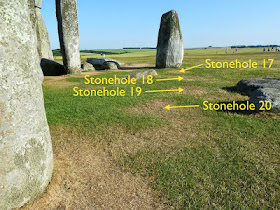Acknowledgement: Anthony Johnson
Simon Banton's excellent site is getting better and better all the time -- it is now really very informative, and I hope that it will attract comments from others who hold information about particular stones. Congratulations to him, and thanks for all the hard work!
http://www.stonesofstonehenge.org.uk/p/about-this-site.html
Simon has added a comment on the missing stones and the parchmarks:
Four sarsen stones that might be expected to complete the sarsen circle are also missing (eg Stones 13, 17, 18 and 20) and so those stones do not have pages either. Evidence that the sarsen circle was intended to be complete arose during the dry summer of 2013 when a series of parch marks appeared in the circuit exactly where some of the missing uprights should be.
Simon Banton, Mark Bowden, Tim Daw, Damian Grady and Sharon Soutar (2014). Parchmarks at Stonehenge, July 2013. Antiquity, 88, pp 733-739. doi:10.1017/S0003598X00050651
I note that he uses the words "evidence that the sarsen circle was intended to be complete......." rather than saying "evidence that the sarsen circle was complete......." I'm happy with that, since as I have said before, the fact that there may have been pits in the places designated does not actually mean that they ever held stones -- and so the evidence cannot be taken to show that Stonehenge was once a complete monument.
Acknowledgement: Simon Bowden


One of the authors of this 2013 Antiquity article cited is Mark Bowden. He is the co - author (along with Sharon Soutar and David Field amongst others) of 2015's "Stonehenge: Understanding the Landscape, Historic England, £30.
ReplyDeleteSimon's phrasing is quite correct but it is worth noting that the parchmarks were not simple round space marking shapes but were each a different irregular oblong as though they had been dug for specific stones. A small point but it is a hint that maybe they did actually hold stones.
ReplyDeleteHi Brian,
ReplyDeleteYes - there is no direct evidence that there were ever stones in the four Southwest holes. (Not without excavation anyway ...)
But I submit that chalk is quite dense and difficult to dig, and further, there's no evidence that the builders were big waster's of effort. I believe the Stones were erected sequentially, over time. (There's credible suggestions that the Ring may have taken +/- 100 years to complete).
So, I guess I'm saying: Why expend the effort to situate holes EXACTLY where they would complete the Circle, yet put nothing in them?
Where's the chalk spoil from an empty hole? Several chalk piles under turf don't magically disappear, therefore it's unlikely that they dug those pits and then just walked away.
The evidence for stones in those holes, though indirect, is compelling.
"In the worst case, intention remains."
________________________
PS: For those who will almost certainly throw the Y&Z Holes up as an example of 'wasted effort', I answer: Those went in about 700 years after the Sarsen phase ended; by a different society.
Best Wishes,
Neil
Neil and Tim
ReplyDeleteThis is an interesting issue. The article is behind a paywall -- some might wish to comment, but it would be best to read it first! Is it available somewhere.....?
https://www.dropbox.com/sh/vh7hhugyb5bp0ys/0wJttnAby9 has detailed pictures of all the parchmarks
ReplyDeleteThanks Tim -- these are actually not all that helpful. Where is the article available for those who do not subscribe to this learned journal?
ReplyDeleteThere is a good description and discussion on Tim's blog, here:
ReplyDeletehttp://www.sarsen.org/2013/07/non-completion-theory-of-stonehenge-and.html